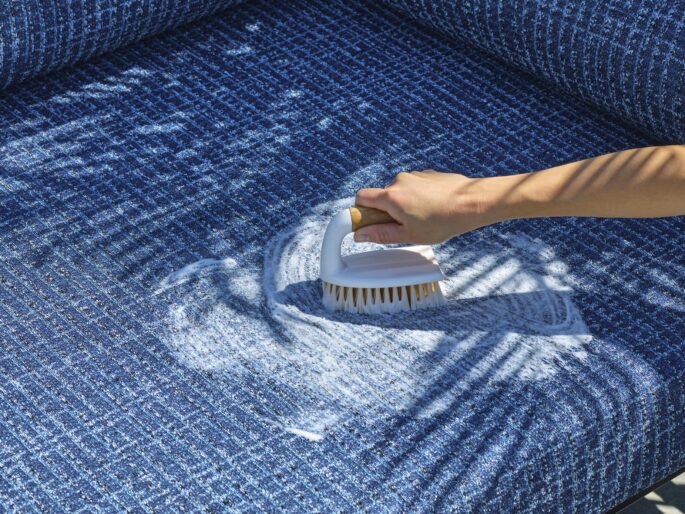Facilities today face stricter cleaning and maintenance standards, as the general public continues to become more informed about climate health, sustainability, and the environment. This means that conscious practices are a priority for specifiers and end users. The selection of materials, particularly textiles, can play a crucial role in reducing the demands on facility maintenance staff, as well as creating sustainable and healthy indoor environments. Whether you are completing a renovation or simply updating your furniture or coverings, consider cleanability and durability to save money and lessen your environmental impact.
RELATED: ESG and the commercial cleaning industry
The value of long-lasting interior elements
The pandemic has certainly transformed the perception of sanitation and cleanliness in public spaces. Whether it’s hotels, healthcare facilities, offices, or other high-traffic environments, rigorous cleaning protocols are crucial. By selecting textiles that can withstand harsh conditions and heavy use without degrading, facility managers ensure the longevity of these surfaces while supporting sustainable practices. Cleanability not only enhances the health and wellness of a building’s inhabitants but also prolongs the life of the materials themselves, a crucial element of sustainable design.
Investing in cleanable and durable textiles benefits facility owners and managers by reducing time and expense attributed to rigorous maintenance procedures and frequent renovations. In an industry that continuously grapples with labour shortages, making daily cleaning and maintenance tasks easier and more effective is essential. Quality textiles for wallcoverings, upholstery, and drapery are built to withstand wear and tear over many years, reducing the frequency of replacements and repairs, while lowering maintenance costs.
By focusing on the longevity of these interior elements, businesses minimize the need for renovations and prevent unneeded consumption of resources and materials, making it a financially responsible and environmentally friendly choice.
A resurgent emphasis on wellness has influenced facility design to offer occupants a deeper connection with nature. Commercial facilities that previously wouldn’t consider creating outdoor spaces are now requesting seamless design connections between the indoors and outdoors. This can look like spaces with open-air configurations, flexible exterior environments, or outdoor pavilions. As textiles in these adapted spaces will be subjected to withstand adverse weather, dirt, extreme temperature fluctuations, and fading from sun exposure, durability and cleanability become even more crucial for textile selection.
The environmental Impact of cleanable and durable textiles
Selecting cleanable and durable textiles contributes significantly to a sustainable environment. Durability ensures a longer life cycle for the product, reducing the need for frequent replacements and refurbishments. This, in turn, minimizes waste generation and conserves valuable resources. Opting for materials from reputable manufacturers with take-back policies or recycling initiatives aligns with the principles of a circular economy and will allow you to go greener.
The manufacturing process is one of the most critical aspects of sustainable material selection. Many traditional approaches to creating textiles have been found to have adverse effects on both the environment and the health of building occupants. For instance, PVC, also known as vinyl, has been deemed one of the most toxic substances saturating our planet by organizations like Greenpeace. This awareness has prompted facilities and designers to seek alternatives to PVC and specify plant-based sustainable products that are third-party certified.
Innovative trends in commercial textile design
The growing emphasis on high-performance/low-maintenance fabrics has driven several innovative trends in the commercial design industry in recent years. Of note, coated fabrics are becoming increasingly popular across all sectors because they are wipeable and easy to maintain. Because of the demand, options for these materials have evolved in the last few years to include affordable coated fabrics that mimic the texture of woven textiles and offer warmer, more tactile aesthetics reminiscent of hospitality or residential interiors.
Across the commercial interiors industry, facility designers have noticed an increased prioritization of interior health, with clients and specifiers seeking options that improve air quality and occupant well-being. Materials that avoid substances like PVC are becoming more popular as a result. Sustainability innovation is also thriving, with previously impossible advancements such as fabrics made from 100 per cent recycled content and high-performance biobased materials redefining commercial design practices.
Emphasizing the importance of selecting cleanable and durable textiles in facility design is paramount, from a labour to cleaning to an environmental perspective. From the manufacturing process to its environmental impact, as well as its influence on the health and well-being of building occupants and the economic benefits, the advantages of choosing wisely are significant.
The collective shift toward a more responsible and conscious approach to crafting indoor spaces is evident. And by deliberately opting for materials that not only withstand the test of time but also support sustainable manufacturing practices, facility designers and managers can substantially contribute to a healthier planet and pave the way for a better future for generations.
Heather Bush is the Chief Creative Officer of Carnegie and has been a leader at the company for the past 26 years. Her work over the years has helped ensure Carnegie’s reputation for authentic commitment to the environment and responsible innovation through every part of its business cycle.









